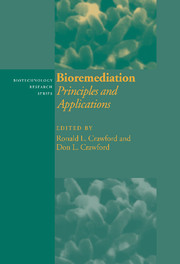Book contents
- Frontmatter
- Contents
- List of contributors
- Preface
- Introduction
- 1 Engineering of bioremediation processes: needs and limitations
- 2 Bioremediation in soil: influence of soil properties on organic contaminants and bacteria
- 3 Biodegradation of ‘BTEX’ hydrocarbons under anaerobic conditions
- 4 Bioremediation of petroleum contamination
- 5 Bioremediation of environments contaminated by polycyclic aromatic hydrocarbons
- 6 Bioremediation of nitroaromatic compounds
- 7 A history of PCB biodegradation
- 8 Bioremediation of chlorinated phenols
- 9 Biodegradation of chlorinated aliphatic compounds
- 10 Microbial remediation of metals
- 11 Molecular techniques in bioremediation
- Index
7 - A history of PCB biodegradation
Published online by Cambridge University Press: 28 October 2009
- Frontmatter
- Contents
- List of contributors
- Preface
- Introduction
- 1 Engineering of bioremediation processes: needs and limitations
- 2 Bioremediation in soil: influence of soil properties on organic contaminants and bacteria
- 3 Biodegradation of ‘BTEX’ hydrocarbons under anaerobic conditions
- 4 Bioremediation of petroleum contamination
- 5 Bioremediation of environments contaminated by polycyclic aromatic hydrocarbons
- 6 Bioremediation of nitroaromatic compounds
- 7 A history of PCB biodegradation
- 8 Bioremediation of chlorinated phenols
- 9 Biodegradation of chlorinated aliphatic compounds
- 10 Microbial remediation of metals
- 11 Molecular techniques in bioremediation
- Index
Summary
Introduction
Polychlorinated biphenyls (PCBs) are a group of related chemicals (congeners) which were produced during the middle of this century as chlorinated derivatives of biphenyl. There are 209 congeners distinguished by the number and position of chlorine atoms on a biphenyl backbone, although many of these congeners are not found in the commercial PCB mixtures (marketed under the tradename ‘Aroclor’ in the U.S., ‘Clophen’ in Europe, and ‘Kaneclor’ in Japan) (Ballschmiter & Zell, 1980; Hutzinger et al., 1983; Erickson, 1992). The chemical and thermal stability of these compounds formed the basis for the widespread use of PCBs as the fire-retardant fluid in electrical equipment, heat exchangers, hydraulic fluids, and compressor fluids. However, this chemical stability also carried with it a degree of biological stability that has resulted in the accumulation of PCBs at sites of its manufacture, use, storage, and disposal.
Although the term PCBs has evoked the specter of the grim reaper, at the outset of this review it should be stated that this visceral response to PCBs has at times bordered on the irrational. As our society moves into the next century and we increasingly address our environmental problems, we must take a realistic view of the true risks posed by each of the chemical targets that we address. It should also be remembered that in their time PCBs were an important life-saving invention. Prior to 1929 electrical equipment contained flammable fluids which often ignited, creating conflagrations that truly posed serious risks to human health. The use of chlorinated organics, including PCBs, as fire-retardant liquids helped create a safer environment for our growing industrial society.
- Type
- Chapter
- Information
- BioremediationPrinciples and Applications, pp. 209 - 253Publisher: Cambridge University PressPrint publication year: 1996
- 20
- Cited by



